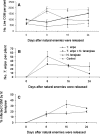Interactions between the predatory mite Typhlodromalus aripo and the entomopathogenic fungus Neozygites tanajoae and consequences for the suppression of their shared prey/host Mononychellus tanajoa
- PMID: 23104107
- PMCID: PMC3641303
- DOI: 10.1007/s10493-012-9630-1
Interactions between the predatory mite Typhlodromalus aripo and the entomopathogenic fungus Neozygites tanajoae and consequences for the suppression of their shared prey/host Mononychellus tanajoa
Abstract
The predatory mite Typhlodromalus aripo and the entomopathogenic fungus Neozygites tanajoae, both introduced from Brazil for control of the cassava green mite (CGM) Mononychellus tanajoa, now co-occur in cassava fields in Benin. However, studies on interactions between these two natural enemies and how they might affect CGM biological control are lacking. We determined in screenhouse experiments the effects of single and combined releases of N. tanajoae and T. aripo on CGM suppression. In the single natural enemy treatment, both T. aripo and N. tanajoae significantly reduced CGM densities, but the results of the predator (T. aripo) are more quickly measurable than those of the pathogen (N. tanajoae) in our short-term experiment. The level of CGM suppression in the combined natural enemy treatment was reduced considerably compared with T. aripo-alone, but only slightly when compared with N. tanajoae alone, with a simultaneous reduction in T. aripo and N. tanajoae abundance or prevalence. In a laboratory experiment, T. aripo fed more on N. tanajoae-infected CGM than on healthy CGM and its oviposition and survival were reduced when fed on the former compared with the latter, which can help in explaining the reduction in numbers of T. aripo and consequently the considerable loss in suppression of CGM in the combined natural enemy treatment in the screenhouse experiment. Together, the screenhouse and the laboratory experiments predicted negative interactions between the two natural enemies with negative consequences for CGM biological control. Long-term field observations and rigorous field experiments that simultaneously manipulate T. aripo and N. tanajoae abundance and prevalence are needed to validate the prediction of this study.
Figures



References
-
- Agboton VB, Delalibera I, Jr, Hanna R, von Tiedemann A. Molecular detection and differentiation of Brazilian and African strains of the entomopathogen Neozygites tanajoae (Entomophthorales: Neozygitaceae) with PCR using specific primers. Biocontrol Sci Technol. 2009;19:67–79. doi: 10.1080/09583150802588532. - DOI
-
- Agboton VB, Hanna R, Hountondji FCC, von Tiedemann A. Pathogenicity and host specificity of Brazilian and African isolates of the acaropathogenic fungus Neozygites tanajoae to mite species associated with cassava. J Appl Entomol. 2009;133:651–658. doi: 10.1111/j.1439-0418.2009.01415.x. - DOI
-
- Alvarez Afanador JM, Acosta A, Bellotti AC, Braun AR. Pathogenicity studies of a fungus associated to the cassava (Manihot esculenta Crantz) pest Mononychellus tanajoa (Bondar) Revista Colomb de Entomol. 1993;19:10–20.
-
- Ariori SL, Dara SK. Predation of Neozygites tanajoae infected cassava green mites by the predatory mite, Typhlodromalus aripo (Acari: Phytoseiidae) Agriculturae Conspectus Scientificus. 2007;72:169–172.
-
- Boucias DG, Pendland JC. Principles of insect pathology. Boston: Kluwer; 1998. p. 548.
Publication types
MeSH terms
LinkOut - more resources
Full Text Sources
Medical

